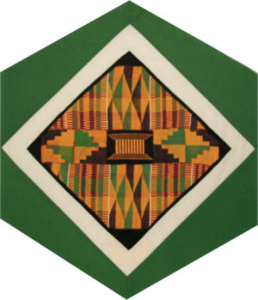Ghana

The Block
The result of a collaborative effort by Sue Robertson, Gerald and Stela Arhin, and Tom Forson features woven geometric stylizations in rich earth tones that surround an image of the Ashanti king’s throne. This kind of weaving is typical of West Africa’s best known fabric, Kente cloth (a visual reflection of history, philosophy, oral literature, and social values), that has come to be used in the national dress of Ghana. Men of the village weave narrow strips in cotton or silk, using complex patterns in a wide array of colours. Each colour is chosen for its visual effect as well as for its symbolic meaning. The strips are then cut and sewn together lengthwise to produce toga-like wraps used by both men and women.
A man’s cloth will typically measure 24 strips, while a woman’s cloth will range between five and twelve strips. Legend has it that Kente cloth originated in the town of Bonwire (now the leading Kente weaving centre in Ashanti) when Ota Karaban and Kwaku Ameyaw taught themselves the art by observing a spider weaving its web. Originally reserved for royalty and limited to special social and sacred occasions, Kente cloth is still used today for garments, as well as for wall hangings, placemats, bell pulls, and other decorative purposes.
Cultural Profile
Ghana, a former British colony, is situated in the southern part of West Africa. Once called Costa D’Oro (Gold Coast) by the Portuguese, who came looking for the precious metal in the 1600s, Ghana takes its name from the ancient Ghana Empire. In 1957 it became the first nation in sub-Saharan Africa to gain independence. Ghana is one of four countries (including Côte d’Ivoire, Nigeria and Cameroon) that, together, produce 70 percent of the world’s cacao. The country also has vast resources of oil, natural gas, gold and diamonds. The nation’s eastern regions are home to baobab trees, which have the biggest trunks of any tree in the world, and one of the world’s largest lakes, Lake Volta, was created by damming its biggest river, the Volta.
Ghana is comprised of numerous linguistic and ethnic groups with over 100 identified. The principal identities are the Akan (including the Asante and Fante), Mole-Dagbani, Ewé, and Ga-Adangme. English is the official language, although many regional tongues are spoken as well.
Ghanaian life revolves around several central beliefs, including the importance of family ties in which a family’s honour is directly influenced by its members’ actions. Other key values include respect for elders, nearness of ancestral spirits, and the existence of a supreme being. The observance of ceremony is important to Ghanaians who hold special rituals for every event in life including birth, child-naming, puberty, marriage, death, as well as the planting and harvesting of crops. Many of these celebrations involve a magnificent show of colours, song, music and dance.
Ghana’s culture is as diverse as its linguistic and geographical regions. The country is well known for its traditional talking drums, a technique that is taught in the elementary schools. The ‘highlife’ style of music is also a popular Ghanaian export. The genre originated in the early 20th century and features traditional Akan rhythms played with Western instruments such as guitars and horns. The country’s oral traditions are central to Ghanaian culture. Storytelling, the most popular way of transmitting societal values, is a favourite and treasured pastime which often conveys a moral lesson.
Ghana is also known for adinkra cloth. Symbols with various meaning are printed on handwoven cotton, using natural black dye obtained from the badie tree. The printing stamps are made of carved calabashes.Though traditionally the fabric was red, black, unbleached or dark brown, adinkra cloth is now produced in a wide array of colours. The country is also a centre for the production of wax-resist cotton, a staple of West African clothing. Cotton fiber, imported from neighboring countries such as Togo, Benin, Côte d’Ivoire, is still spun, woven and dyed with colourful designs.
Ghana’s traditional crafts also include gold ceremonial pieces made using the lost wax process, gold-covered woodcarvings, embroidered chiefs’ umbrellas, pottery, and metalwork, such as the small brass figurines known as Mrammuo. The Ashanti tribe in particular is famous for its craftwork, which includes hand-carved wooden stools (the Golden Stool is the symbol of the Ashanti nation) used in domestic and sacred roles, and fertility dolls.
People are recorded as coming to Canada from Ghana since 1974, the year immigration records began listing individual nations instead of grouping them under regional designations. There are now several Ghanaian communities throughout the country. The 30,000 Ghanians living in Canada have made contributions to numerous areas of Canadian society, including in the fields of medicine, education, and cuisine. Their influence is perhaps most evident in the artistic, textile and music world. The driving force behind the annual African Music Festival, for example, is Ghana-born physician, Dr Thadi Ulzen. Celebrations for the independence of Ghana are also celebrated during ‘Kente dances’ held yearly in Toronto and Vancouver.
Sponsor: Elizabeth Ferguson
